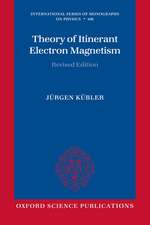Low-Dimensional Electronic Properties of Molybdenum Bronzes and Oxides: Physics and Chemistry of Materials with Low-Dimensional Structures, cartea 11
Editat de C. Schlenkeren Limba Engleză Paperback – oct 2011
Din seria Physics and Chemistry of Materials with Low-Dimensional Structures
- 18%
 Preț: 1830.49 lei
Preț: 1830.49 lei - 18%
 Preț: 1232.26 lei
Preț: 1232.26 lei - 18%
 Preț: 1223.55 lei
Preț: 1223.55 lei - 18%
 Preț: 1225.16 lei
Preț: 1225.16 lei - 18%
 Preț: 1225.31 lei
Preț: 1225.31 lei - 18%
 Preț: 1833.33 lei
Preț: 1833.33 lei - 18%
 Preț: 1230.53 lei
Preț: 1230.53 lei - 18%
 Preț: 1228.47 lei
Preț: 1228.47 lei -
 Preț: 402.98 lei
Preț: 402.98 lei - 18%
 Preț: 1231.01 lei
Preț: 1231.01 lei -
 Preț: 386.99 lei
Preț: 386.99 lei - 18%
 Preț: 952.57 lei
Preț: 952.57 lei - 18%
 Preț: 1227.99 lei
Preț: 1227.99 lei - 18%
 Preț: 962.18 lei
Preț: 962.18 lei - 15%
 Preț: 586.37 lei
Preț: 586.37 lei - 18%
 Preț: 1229.73 lei
Preț: 1229.73 lei
Preț: 398.15 lei
Nou
Puncte Express: 597
Preț estimativ în valută:
76.18€ • 79.54$ • 63.05£
76.18€ • 79.54$ • 63.05£
Carte tipărită la comandă
Livrare economică 04-18 aprilie
Preluare comenzi: 021 569.72.76
Specificații
ISBN-13: 9789401066853
ISBN-10: 940106685X
Pagini: 472
Ilustrații: 472 p.
Dimensiuni: 155 x 235 x 25 mm
Greutate: 0.65 kg
Ediția:1989
Editura: SPRINGER NETHERLANDS
Colecția Springer
Seria Physics and Chemistry of Materials with Low-Dimensional Structures
Locul publicării:Dordrecht, Netherlands
ISBN-10: 940106685X
Pagini: 472
Ilustrații: 472 p.
Dimensiuni: 155 x 235 x 25 mm
Greutate: 0.65 kg
Ediția:1989
Editura: SPRINGER NETHERLANDS
Colecția Springer
Seria Physics and Chemistry of Materials with Low-Dimensional Structures
Locul publicării:Dordrecht, Netherlands
Public țintă
ResearchCuprins
Transition Metal Oxide Bronzes with Quasi Low-Dimensional Properties.- 1. Introduction.- 2. Band Structure and Electronic Properties of Oxide Bronzes.- 3. Molybdenum Bronzes.- 4. Vanadium Bronzes with Quasi Low-Dimensional Properties — ?-AxV2O5.- 5. Tungsten Bronzes with Quasi Low-Dimensional Properties.- Acknowledgements.- References.- On Structural Aspects of Molybdenum Bronzes and Molybdenum Oxides in Relation to Their Low-Dimensional Transport Properties.- 1. Introduction.- 2. Molybdenum Bronzes.- 3. Molybdenum Oxides.- Acknowledgements.- References.- Structural Instabilities in the Low Dimensional Molybdenum Bronzes and Oxides.- 1. Introduction.- 2. The Charge Density Wave Instability.- 3. The Blue Bronzes A0.3MoO3 (A = K, Rb, Tl).- 4. Other Oxides.- 5. Conclusion.- Appendix A.- Appendix B.- Notes.- References.- Charge Density Wave Instabilities and Transport Properties of the Low Dimensional Molybdenum Bronzes and Oxides.- 1. Introduction.- 2. Theoretical Background.- 3. Quasi One-Dimensional Compounds: The Blue Bronzes A0.30MoO3.- 4. Quasi Two-Dimensional Compounds: The Molybdenum Purple Bronzes and the Molybdenum Oxides.- 5. Conclusion.- Acknowledgements.- References.- Frequency-Dependent Conductivity in K0.30MoO3.- 1. Introduction.- 2. Dielectric Relaxation Regime.- 3. Phase Mode Regime.- 4. Far Infrared Regime.- 5. Normal-Electron Screening.- 6. Summary.- Acknowledgements.- References.- Breaking of Analyticity in Charge Density Wave Systems: Physical Interpretation and Consequences.- 1. Introduction: The Peierls Instability in 1D Conductors.- 2. The Transition by Breaking of Analyticity (TBA) in the Discrete Frenkel—Kontorova (FK) Model.- 3. Another Transition by Breaking of Analyticity: The Localization Transition of Electrons in an IncommensuratePotential.- 4. The Transition by Breaking of Analyticity in One-Dimensional Peierls Chains.- 5. Future Prospects: Quantum Lattice Effects and Thermal Effects.- Acknowledgements.- References.- Imperfections of Charge Density Waves in Blue Bronzes.- 1. Introduction.- 2. Properties of Static Imperfections of CDWs.- 3. Interaction of CDW with Lattice Defects.- 4. Elastic and Anelastic Responses of CDW.- 5. Plastic Properties of CDW.- 6. Conclusions.- Acknowledgements.- References.



















